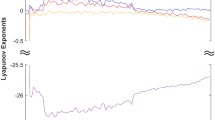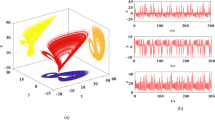Abstract
As a classical volume-conservative system, the Nosé-Hoover oscillator can generate conservative chaos and nested invariant tori. In this paper, a new 3D system is derived from the Nosé-Hoover oscillator in which the coexisting phenomenon of conservative flow and dissipative attractor is discovered. We first numerically analyze the equilibrium points and their stabilities, and study the fold-Hopf bifurcation at the critical point. Then, the dynamic behaviors of the system are studied, besides the coexisting phenomenon, the system also has transient chaos. More interestingly, we find that the increase of parameter has a significant effect on enhancing the ergodicity of the system, which is also proved by the cross section with no “holes”. Furthermore, we design a pseudo-random number generator based on the new system. Numerical results show that this PRNG can generate pseudo-random sequences with high randomness and is suitable for image encryption. Finally, we implement the system using FPGA technology.



















Similar content being viewed by others
Data availability
Some or all data, models, or code generated or used during the study are available from the corresponding author by request.
References
Lorenz, E.N.: Deterministic nonperiodic flow. J. Atmos. Sci. 20(2), 130 (1963)
Chen, G., Ueta, T.: Yet another chaotic attractor. Int. J. Bifur. Chaos 9(07), 1465 (1999)
Shuichi, N.: Constant temperature molecular dynamics methods. Progr. Theor. Phys. Suppl. 103, 1 (1991)
Nosé, S.: A unified formulation of the constant temperature molecular dynamics methods. J. Chem. Phys. 81(1), 511 (1984)
Hoover, W.G.: Canonical dynamics: equilibrium phase-space distributions. Phys. Rev. A 31(3), 1695 (1985)
Sprott, J.C.: Some simple chaotic flows. Phys. Rev. E 50(2), R647 (1994)
Hoover, W.G.: Remark on “aSome simple chaotic flows’’. Phys. Rev. E 51(1), 759 (1995)
Messias, M., Reinol, A.C.: On the formation of hidden chaotic attractors and nested invariant tori in the Sprott A system. Nonlinear Dyn. 88(2), 807 (2017)
Messias, M., Reinol, A.C.: On the existence of periodic orbits and KAM tori in the Sprott A system: a special case of the Nosé-Hoover oscillator. Nonlinear Dyn. 92(3), 1287 (2018)
Jia, H., Shi, W., Wang, L., Qi, G.: Energy analysis of Sprott-A system and generation of a new Hamiltonian conservative chaotic system with coexisting hidden attractors. Chaos, Solitons Fract. 133, 109635 (2020)
Sprott, J.: Variants of the Nosé-Hoover oscillator. Eur. Phys. J. Special Topics 229(6), 963 (2020)
Wang, L., Yang, X.S.: The coexistence of invariant tori and topological horseshoe in a generalized Nosé-Hoover oscillator. Int. J. Bifurc. Chaos 27(07), 1750111 (2017)
Cang, S., Li, Y., Xue, W., Wang, Z., Chen, Z.: Conservative chaos and invariant tori in the modified Sprott A system. Nonlinear Dyn. 99(2), 1699 (2020)
Kuznetsov, Y.A.: Elements of applied bifurcation theory. Springer Science & Business Media, NY (2013)
Bosi, S., Desmarchelier, D.: Local bifurcations of three and four-dimensional systems: a tractable characterization with economic applications. Math. Soc. Sci. 97, 38 (2019)
Martini, D., Innocenti, G., Tesi, A.: Detection of subcritical Hopf and fold bifurcations in an aeroelastic system via the describing function method. Chaos, Solitons Fractals 157, 111892 (2022)
Bisquert, J.: Hopf bifurcations in electrochemical, neuronal, and semiconductor systems analysis by impedance spectroscopy. Appl. Phys. Rev. 9(1), 011318 (2022)
Chan-López, E., Castellanos, V.: Biological control in a simple ecological model via subcritical Hopf and Bogdanov-Takens bifurcations. Chaos, Solitons Fractals 157, 111921 (2022)
Chen, M., Wu, R., Liu, B., Chen, L.: Hopf-Hopf bifurcation in the delayed nutrient-microorganism model. Appl. Math. Modell. 86, 460 (2020)
Zhen, B., Xu, J.: Fold-Hopf bifurcation analysis for a coupled Fitzhugh-Nagumo neural system with time delay. Int. J. Bifurc. Chaos 20(12), 3919 (2010)
Hussein, N.H., Amen, A.I.: Zero-Hopf bifurcation in the generalized stretch-twist-fold flow. Sultan Qaboos Univ. J. Sci. 24(2), 122 (2019)
Li, Y., Chen, Z., Yuan, M., Cang, S.: The transition from conservative to dissipative flows in class-B laser model with fold-Hopf bifurcation and coexisting attractors, Chinese Physics B (2021)
Lai, Y.C., Tél, T.: Transient chaos: complex dynamics on finite time scales. Springer Science & Business Media, NY (2011)
Scott, S.K., Peng, B., Tomlin, A.S., Showalter, K.: Transient chaos in a closed chemical system. J. Chem. Phys. 94(2), 1134 (1991)
Yang, X.S., Yuan, Q.: Chaos and transient chaos in simple Hopfield neural networks. Neurocomputing 69(1–3), 232 (2005)
Yousefpour, A., Jahanshahi, H., Munoz-Pacheco, J.M., Bekiros, S., Wei, Z.: A fractional-order hyper-chaotic economic system with transient chaos. Chaos, Solitons Fractals 130, 109400 (2020)
Ullah, A., Jamal, S.S., Shah, T.: A novel scheme for image encryption using substitution box and chaotic system. Nonlinear Dyn. 91(1), 359 (2018)
Özkaynak, F.: Brief review on application of nonlinear dynamics in image encryption. Nonlinear Dyn. 92(2), 305 (2018)
Fraser, A.M., Swinney, H.L.: Independent coordinates for strange attractors from mutual information. Phys. Rev. A 33(2), 1134 (1986)
Cheng, G., Wang, C., Chen, H.: A novel color image encryption algorithm based on hyperchaotic system and permutation-diffusion architecture. Int. J. Bifurc. Chaos 29(09), 1950115 (2019)
Yin, Q., Wang, C.: A new chaotic image encryption scheme using breadth-first search and dynamic diffusion. Int. J. Bifurc. Chaos 28(04), 1850047 (2018)
Qi, G., Hu, J.: Modelling of both energy and volume conservative chaotic systems and their mechanism analyses. Commun. Nonlinear Sci. Numer. Simul. 84, 105171 (2020)
Cang, S., Kang, Z., Wang, Z.: Pseudo-random number generator based on a generalized conservative Sprott-A system. Nonlinear Dyn. 104(1), 827 (2021)
Zhang, Z., Huang, L.: A new 5D Hamiltonian conservative hyperchaotic system with four center type equilibrium points, wide range and coexisting hyperchaotic orbits. Nonlinear Dyn. 1, 16 (2022)
Legoll, F., Luskin, M., Moeckel, R.: Non-ergodicity of Nosé-Hoover dynamics. Nonlinearity 22(7), 1673 (2009)
Thamilmaran, K., Sabarathinam, S.: Transient chaos in a globally coupled system of nearly conservative Hamiltonian Duffing oscillators, Chaos, Solitons and Fractals: Applications in Science and Engineering: An Interdisciplinary. J. Nonlinear Sci. 73, 129 (2015)
Cang, S., Li, Y., Kang, Z., Wang, Z.: A generic method for constructing n-fold covers of 3D conservative chaotic systems. Chaos: Interdiscipl. J. Nonlinear Sci. 30(3), 033103 (2020)
Bryuno, A.: The normal form of a Hamiltonian system. Russian Math. Surv. 43(1), 25 (1988)
Faradja, P., Qi, G.: Hamiltonian-based energy analysis for brushless DC motor chaotic system. Int. J. Bifurc. Chaos 30(08), 2050112 (2020)
Li, Y., Chen, Z., Wang, Z., Cang, S.: An effective approach for constructing a class of 4D multicluster conservative chaotic systems without external excitation. Int. J. Bifurc. Chaos 31(13), 2150198 (2021)
Martyna, G.J., Klein, M.L., Tuckerman, M.: Nosé-Hoover chains: the canonical ensemble via continuous dynamics. J. Chem. Phys. 97(4), 2635 (1992)
Hu, X., Liu, C., Liu, L., Ni, J., Li, S.: Multi-scroll hidden attractors in improved Sprott A system. Nonlinear Dyn. 86(3), 1725 (2016)
Llibre, J., Messias, M., Reinol, A.C.: Global dynamics and bifurcation of periodic orbits in a modified Nosé-Hoover oscillator. J. Dyn. Control Syst. 27(3), 491 (2021)
Llibre, J., Martínez, Y.P., Valls, C.: Limit cycles bifurcating of Kolmogorov systems in R2 and in R3. Commun. Nonlinear Sci. Numer. Simul. 91, 105401 (2020)
Tigan, G., Llibre, J., Ciurdariu, L.: Degenerate fold-Hopf bifurcations in a Rössler-type system,. Int. J. Bifurc. Chaos 27(5), 1750068 (2017)
Grebogi, C., Ott, E., Yorke, J.A.: Fractal basin boundaries, long-lived chaotic transients, and unstable-unstable pair bifurcation. Phys. Rev. Lett. 50(13), 935 (1983)
Tapias, D., Bravetti, A., Sanders, D.P.: Ergodicity of one-dimensional systems coupled to the logistic thermostat. Comput. Methods Sci. Technol. 23, 1 (2016)
Cang, S., Kang, Z., Wang, Z.: Pseudo-random number generator based on a generalized conservative Sprott-A system. Nonlinear Dyn. 104(1), 1 (2021)
Wang, N., Zhang, G., Bao, H.: Infinitely many coexisting conservative flows in a 4D conservative system inspired by LC circuit. Nonlinear Dyn. 99(2), 1 (2020)
Wang, N., Li, C., Bao, H., Chen, M., Bao, B.: Generating multi-scroll Chua’s attractors via simplified piecewise-linear Chua’s diode. Circuits Syst. I: Regular Papers, IEEE Trans. 66(12), 4767 (2019)
Dong, E., Yuan, M., Du, S., Chen, Z.: A new class of Hamiltonian conservative chaotic systems with multistability and design of pseudo-random number generator. Appl. Math. Modell. 73, 40 (2019)
Qi, G.: Modelings and mechanism analysis underlying both the 4D Euler equations and Hamiltonian conservative chaotic systems. Nonlinear Dyn. 95(3), 2063 (2019)
Li, Y., Cang, S., Kang, Z., Wang, Z.: A new conservative system with isolated invariant tori and six-cluster chaotic flows. Eur. Phys. J. Special Topics 229, 1335 (2020)
Qi, G., Hu, J., Wang, Z.: Modeling of a Hamiltonian conservative chaotic system and its mechanism routes from periodic to quasiperiodic, chaos and strong chaos. Appl. Math. Modell. 78, 350 (2020)
Vaidyanathan, S., Pakiriswamy, S.: A 3-D novel conservative chaotic system and its generalized projective synchronization via adaptive control. J. Eng. Sci. Technol. Rev. 8, 2 (2015)
Singh, J.P., Roy, B.K.: Five new 4-D autonomous conservative chaotic systems with various type of non-hyperbolic and lines of equilibria. Chaos, Solitons Fractals 114, 81 (2018)
Dong, C.: Asymmetric color image encryption scheme using discrete-time map and hash value. Optik 126(20), 2571 (2015)
Acknowledgements
This work is partly supported by the National Natural Science Foundation of China (Grant Nos. 61973175 and 61903274), the TianJin Natural Science Foundation (Grant Nos. 20JCYBJC01060 and 20JCQNJC01450), and the Tianjin Research Innovation Project for Postgraduate Students (Grant No.2021YJSB034).
Funding
The authors have not disclosed any funding.
Author information
Authors and Affiliations
Corresponding author
Ethics declarations
Conflict of interest
The authors declare that they have no conflicts of interest.
Additional information
Publisher's Note
Springer Nature remains neutral with regard to jurisdictional claims in published maps and institutional affiliations.
Rights and permissions
Springer Nature or its licensor (e.g. a society or other partner) holds exclusive rights to this article under a publishing agreement with the author(s) or other rightsholder(s); author self-archiving of the accepted manuscript version of this article is solely governed by the terms of such publishing agreement and applicable law.
About this article
Cite this article
Li, Y., Yuan, M., Chen, Z. et al. Coexistence and ergodicity in a variant Nosé-Hoover oscillator and its FPGA implementation. Nonlinear Dyn 111, 10583–10599 (2023). https://doi.org/10.1007/s11071-023-08347-4
Received:
Accepted:
Published:
Issue Date:
DOI: https://doi.org/10.1007/s11071-023-08347-4




